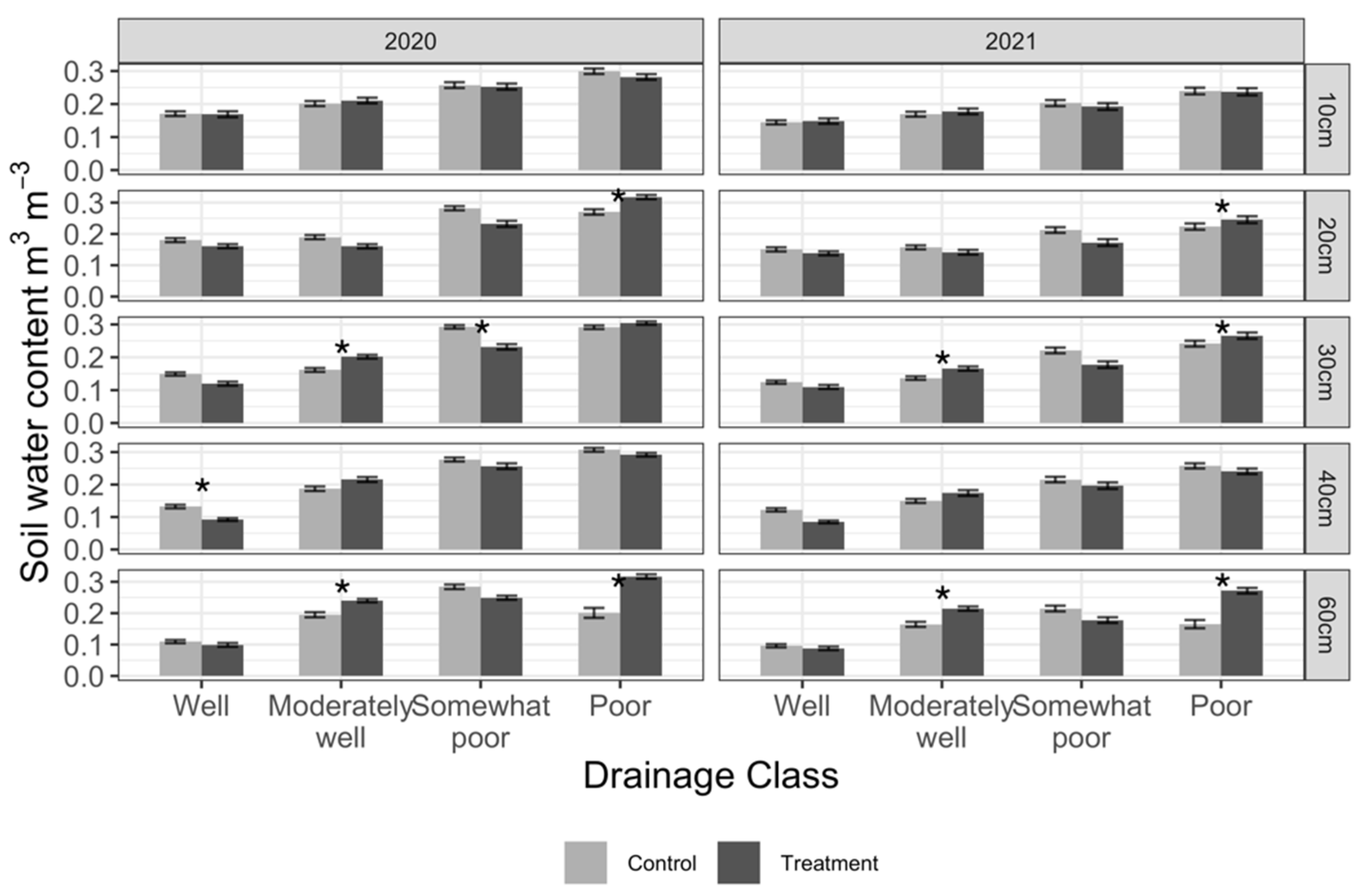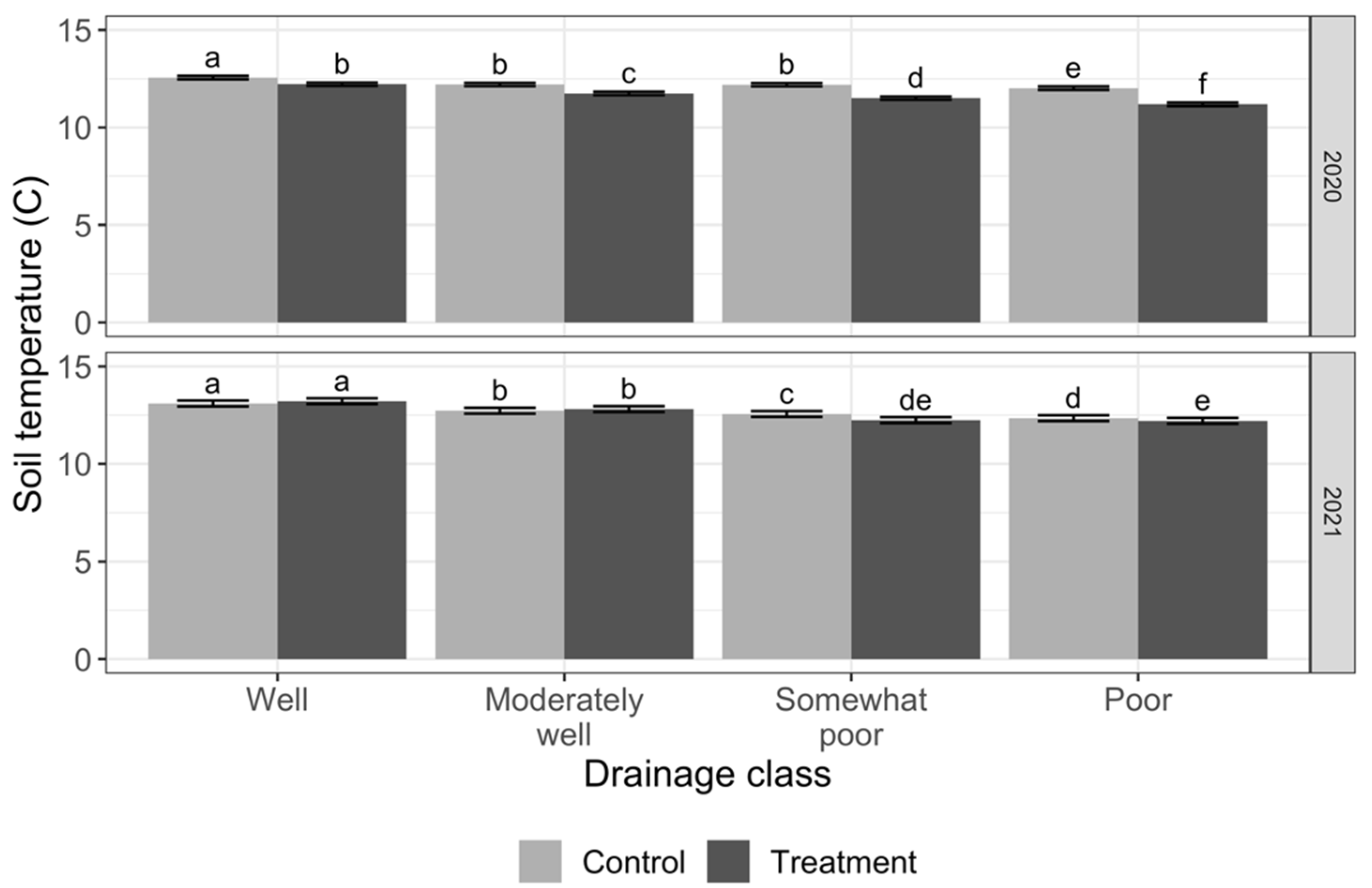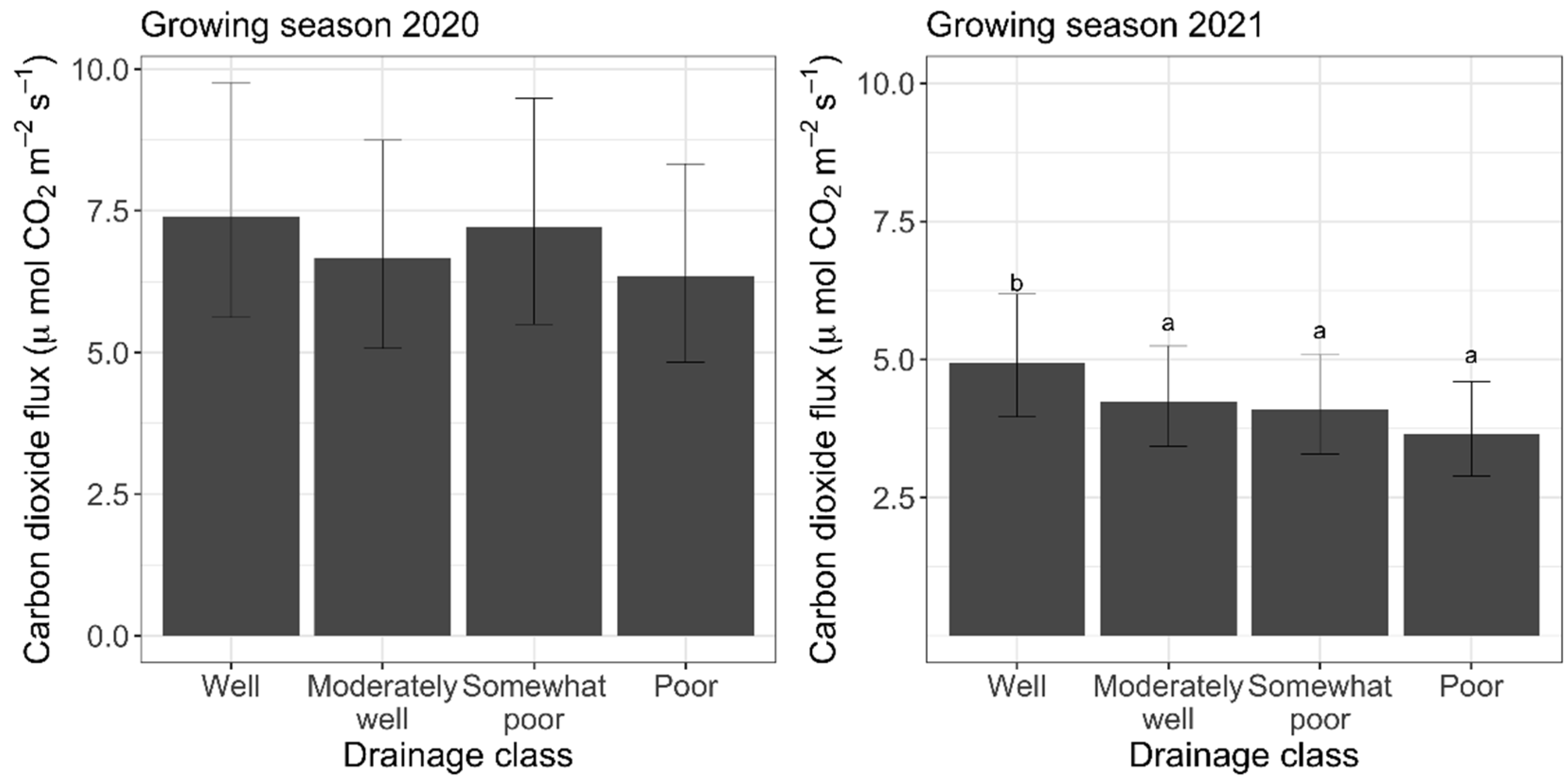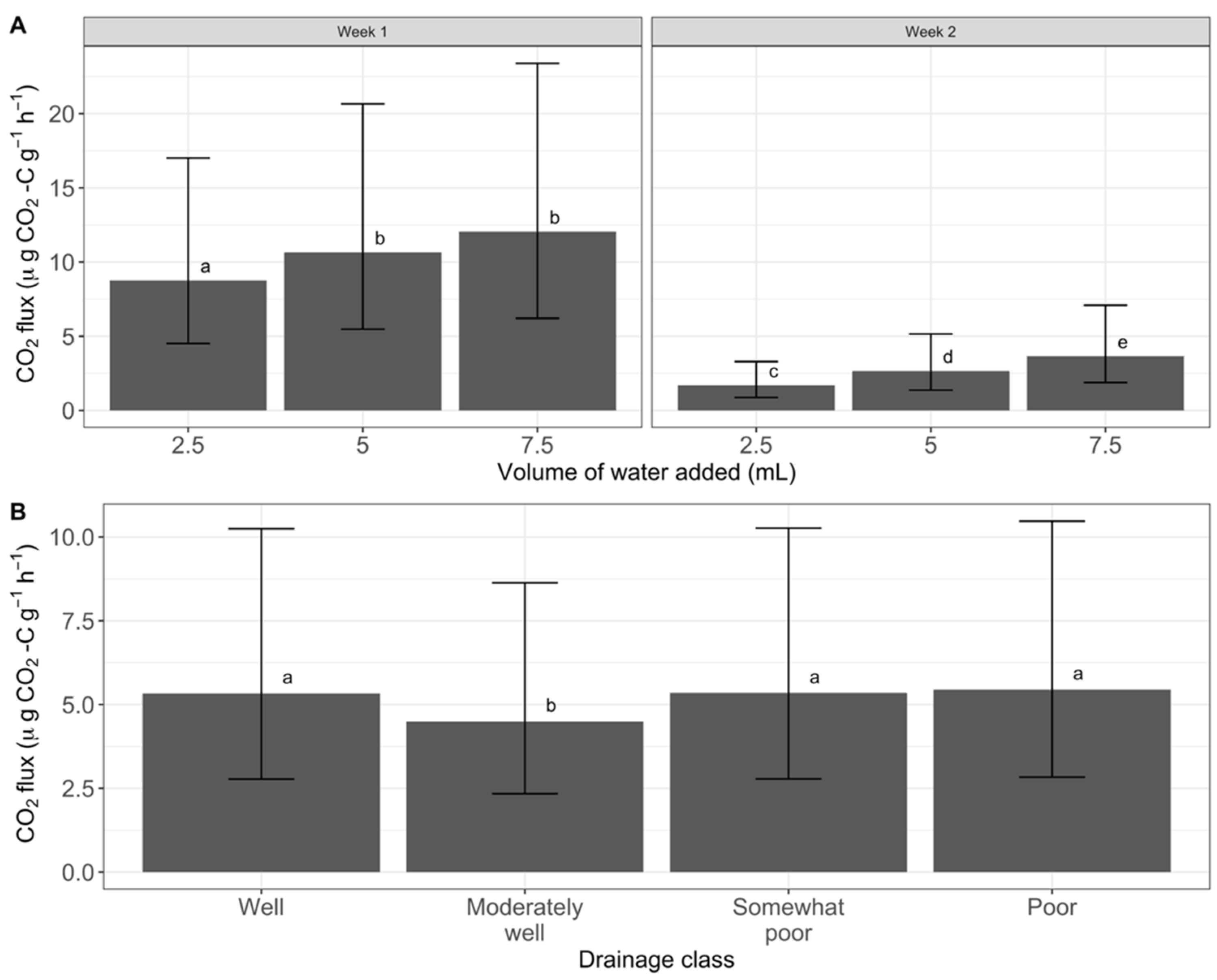Limited Effects of Precipitation Manipulation on Soil Respiration and Inorganic N Concentrations across Soil Drainage Classes in Northern Minnesota Aspen Forests
Abstract
:1. Introduction
2. Materials and Methods
2.1. Study Area
2.2. Site Characteristics
2.3. Experimental Design
2.4. Snow Removal Treatment
2.5. Throughfall Reduction Treatment
2.6. Soil Moisture, Soil Temperature, and Air Temperature Measurements
2.7. In Situ Measurements of Bulk Soil Respiration
2.8. Extractable Soil N
2.9. Laboratory Incubation
2.10. Data Analysis
3. Results
3.1. Effects of Treatment on Soil Water Content and Temperature
3.2. In Situ Bulk Soil Respiration
3.3. Extractable Soil N
3.4. Laboratory Incubation
4. Discussion
4.1. Soil Respiration
4.2. Extractable Soil N
5. Conclusions
Supplementary Materials
Author Contributions
Funding
Institutional Review Board Statement
Informed Consent Statement
Data Availability Statement
Acknowledgments
Conflicts of Interest
References
- Bernal, S.; Hedin, L.O.; Likens, G.E.; Gerber, S.; Buso, D.C. Complex Response of the Forest Nitrogen Cycle to Climate Change. Proc. Natl. Acad. Sci. USA 2012, 109, 3406–3411. [Google Scholar] [CrossRef] [PubMed] [Green Version]
- Schlesinger, W.H.; Andrews, J.A. Soil Respiration and the Global Carbon Cycle. Biogeochemistry 2000, 48, 7–20. [Google Scholar] [CrossRef]
- Wei, W.; Weile, C.; Shaopeng, W. Forest Soil Respiration and Its Heterotrophic and Autotrophic Components: Global Patterns and Responses to Temperature and Precipitation. Soil Biol. Biochem. 2010, 42, 1236–1244. [Google Scholar] [CrossRef]
- Högberg, P.; Read, D.J. Towards a More Plant Physiological Perspective on Soil Ecology. Trends Ecol. Evol. 2006, 21, 548–554. [Google Scholar] [CrossRef] [PubMed]
- Rennenberg, H.; Dannenmann, M.; Gessler, A.; Kreuzwieser, J.; Simon, J.; Papen, H. Nitrogen Balance in Forest Soils: Nutritional Limitation of Plants under Climate Change Stresses. Plant Biol. 2009, 11, 4–23. [Google Scholar] [CrossRef] [PubMed]
- Haaf, D.; Six, J.; Doetterl, S. Global Patterns of Geo-Ecological Controls on the Response of Soil Respiration to Warming. Nat. Clim. Chang. 2021, 11, 623–627. [Google Scholar] [CrossRef]
- Knoepp, J.D.; Swank, W.T. Using Soil Temperature and Moisture to Predict Forest Soil Nitrogen Mineralization. Biol. Fertil. Soils 2002, 36, 177–182. [Google Scholar] [CrossRef]
- Monson, R.K.; Lipson, D.L.; Burns, S.P.; Turnipseed, A.A.; Delany, A.C.; Williams, M.W.; Schmidt, S.K. Winter Forest Soil Respiration Controlled by Climate and Microbial Community Composition. Nature 2006, 439, 711–714. [Google Scholar] [CrossRef] [PubMed]
- Schindlbacher, A.; Wunderlich, S.; Borken, W.; Kitzler, B.; Zechmeister-Boltenstern, S.; Jandl, R. Soil Respiration under Climate Change: Prolonged Summer Drought Offsets Soil Warming Effects. Glob. Chang. Biol. 2012, 18, 2270–2279. [Google Scholar] [CrossRef]
- Borken, W.; Savage, K.; Davidson, E.A.; Trumbore, S.E. Effects of Experimental Drought on Soil Respiration and Radiocarbon Efflux from a Temperate Forest Soil. Glob. Chang. Biol. 2006, 12, 177–193. [Google Scholar] [CrossRef] [Green Version]
- Muhr, J.; Borken, W.; Matzner, E. Effects of Soil Frost on Soil Respiration and Its Radiocarbon Signature in a Norway Spruce Forest Soil. Glob. Chang. Biol. 2009, 15, 782–793. [Google Scholar] [CrossRef]
- Handler, S.; Duveneck, M.J.; Iverson, L.; Peters, E.; Scheller, R.M.; Wythers, K.R.; Brandt, L.; Butler, P.; Janowiak, M.; Shannon, P.D.; et al. Minnesota Forest Ecosystem Vulnerability Assessment and Synthesis: A Report from the Northwoods Climate Change Response Framework Project. In Gen. Tech. Rep. NRS-133. Newtown Square, PA.; U.S. Department of Agriculture, Forest Service, Northern Research Station: Madison, WI, USA, 2014; 228p. [Google Scholar] [CrossRef]
- Collins, M.; Knutti, R.; Arblaster, J.; Dufresne, J.-L.; Fichefet, T.; Gao, X.; Gutowski, W.J., Jr.; Johns, T.; Krinner, G.; Shongwe, M.; et al. Long-Term Climate Change: Projections, Commitments and Irreversibility. In Climate Change 2013—The Physical Science Basis: Contribution of Working Group I to the Fifth Assessment Report of the Intergovernmental Panel on Climate Change; Cambridge University Press: Cambridge, UK, 2013; 108p. [Google Scholar]
- Campbell, J.L.; Ollinger, S.V.; Flerchinger, G.N.; Wicklein, H.; Hayhoe, K.; Bailey, A.S. Past and Projected Future Changes in Snowpack and Soil Frost at the Hubbard Brook Experimental Forest, New Hampshire, USA. Hydrol. Process. 2010, 24, 2465–2480. [Google Scholar] [CrossRef] [Green Version]
- Hardy, J.P.; Groffman, P.M.; Fitzhugh, R.D.; Henry, K.S.; Welman, A.T.; Demers, J.D.; Fahey, T.J.; Driscoll, C.T.; Tierney, G.L.; Nolan, S. Snow Depth Manipulation and Its Influence on Soil Frost and Water Dynamics in a Northern Hardwood Forest. Biogeochemistry 2001, 56, 151–174. [Google Scholar] [CrossRef]
- Öquist, M.G.; Laudon, H. Winter Soil Frost Conditions in Boreal Forests Control Growing Season Soil CO2 Concentration and Its Atmospheric Exchange. Glob. Chang. Biol. 2008, 14, 2839–2847. [Google Scholar] [CrossRef]
- Fitzhugh, R.D.; Driscoll, C.T.; Groffman, P.M.; Tierney, G.L.; Fahey, T.J.; Hardy, J.P. Effects of Soil Freezing Disturbance on Soil Solution Nitrogen, Phosphorus, and Carbon Chemistry in a Northern Hardwood Ecosystem. Biogeochemistry 2001, 56, 215–238. [Google Scholar] [CrossRef]
- Mitchell, M.J.; Driscoll, C.T.; Kahl, J.S.; Murdoch, P.S.; Pardo, L.H. Climatic Control of Nitrate Loss from Forested Watersheds in the Northeast United States. Environ. Sci. Technol. 1996, 30, 2609–2612. [Google Scholar] [CrossRef]
- Homyak, P.M.; Allison, S.D.; Huxman, T.E.; Goulden, M.L.; Treseder, K.K. Effects of Drought Manipulation on Soil Nitrogen Cycling: A Meta-Analysis. J. Geophys. Res. Biogeosci. 2017, 122, 3260–3272. [Google Scholar] [CrossRef] [Green Version]
- Deng, L.; Peng, C.; Kim, D.-G.; Li, J.; Liu, Y.; Hai, X.; Liu, Q.; Huang, C.; Shangguan, Z.; Kuzyakov, Y. Drought Effects on Soil Carbon and Nitrogen Dynamics in Global Natural Ecosystems. Earth Sci. Rev. 2021, 214, 103501. [Google Scholar] [CrossRef]
- Veneman, P.L.M.; Spokas, L.A.; Lindbo, D.L. Soil Moisture and Redoximorphic Features: A Historical Perspective. In Quantifying Soil Hydromorphology; John Wiley & Sons, Ltd.: Hoboken, NJ, USA, 1998; pp. 1–23. [Google Scholar] [CrossRef]
- Briggs, R.D.; Lemin, R.C., Jr. Soil Drainage Class Effects on Early Response of Balsam Fir to Precommercial Thinning. Soil Sci. Soc. Am. J. 1994, 58, 1231–1239. [Google Scholar] [CrossRef]
- Davidson, E.A.; Belk, E.; Boone, R.D. Soil Water Content and Temperature as Independent or Confounded Factors Controlling Soil Respiration in a Temperate Mixed Hardwood Forest. Glob. Chang. Biol. 1998, 4, 217–227. [Google Scholar] [CrossRef] [Green Version]
- Friesen, H.C.; Slesak, R.A.; Karwan, D.L.; Kolka, R.K. Effects of Snow and Climate on Soil Temperature and Frost Development in Forested Peatlands in Minnesota, USA. Geoderma 2021, 394, 115015. [Google Scholar] [CrossRef]
- Ditzler, C.; Scheffe, K.; Monger, H.C. (Eds.) Soil Science Division Staff. In Soil Survey Manual; USDA Handbook 18; Government Printing Office: Washington, DC, USA, 2017. [Google Scholar]
- Yahdjian, L.; Sala, O.E. A Rainout Shelter Design for Intercepting Different Amounts of Rainfall. Oecologia 2002, 133, 95–101. [Google Scholar] [CrossRef] [PubMed]
- Pinheiro, J.; Bates, D.; DebRoy, S.; Sarkar, D.; R Core Team. nlme: Linear and Nonlinear Mixed Effects Models; R Package Version 3.1-153; R Foundation for Statistical Computing: Vienna, Austria, 2021; Available online: https://CRAN.R-project.org/package=nlme (accessed on 1 September 2020).
- Lenth, R.V. Emmeans: Estimated Marginal Means, AKA Least-Squares Means; R Package Version 1.5.4; R Foundation for Statistical Computing: Vienna, Austria, 2021; Available online: https://CRAN.R-project.org/package=emmeans (accessed on 1 September 2020).
- Beier, C.; Beierkuhnlein, C.; Wohlgemuth, T.; Penuelas, J.; Emmett, B.; Körner, C.; de Boeck, H.; Christensen, J.H.; Leuzinger, S.; Janssens, I.A.; et al. Precipitation Manipulation Experiments—Challenges and Recommendations for the Future. Ecol. Lett. 2012, 15, 899–911. [Google Scholar] [CrossRef]
- Fay, P.A.; Carlisle, J.D.; Knapp, A.K.; Blair, J.M.; Collins, S.L. Altering Rainfall Timing and Quantity in a Mesic Grassland Ecosystem: Design and Performance of Rainfall Manipulation Shelters. Ecosystems 2000, 3, 308–319. [Google Scholar] [CrossRef]
- Barba, J.; Curiel Yuste, J.; Poyatos, R.; Janssens, I.A.; Lloret, F. Strong Resilience of Soil Respiration Components to Drought-Induced Die-off Resulting in Forest Secondary Succession. Oecologia 2016, 182, 27–41. [Google Scholar] [CrossRef] [Green Version]
- Schlesinger, W.H.; Dietze, M.C.; Jackson, R.B.; Phillips, R.P.; Rhoades, C.C.; Rustad, L.E.; Vose, J.M. Forest Biogeochemistry in Response to Drought. Glob. Chang. Biol. 2016, 22, 2318–2328. [Google Scholar] [CrossRef]
- Borken, W.; Matzner, E. Reappraisal of Drying and Wetting Effects on C and N Mineralization and Fluxes in Soils. Glob. Chang. Biol. 2009, 15, 808–824. [Google Scholar] [CrossRef]
- Groffman, P.M.; Driscoll, C.T.; Fahey, T.J.; Hardy, J.P.; Fitzhugh, R.D.; Tierney, G.L. Effects of Mild Winter Freezing on Soil Nitrogen and Carbon Dynamics in a Northern Hardwood Forest. Biogeochemistry 2001, 56, 191–213. [Google Scholar] [CrossRef]
- Porporato, A.; D’Odorico, P.; Laio, F.; Rodriguez-Iturbe, I. Hydrologic Controls on Soil Carbon and Nitrogen Cycles. I. Modeling Scheme. Adv. Water Resour. 2003, 26, 45–58. [Google Scholar] [CrossRef]





| Site (County) | Coordinates | Soil Unit | Soil Texture | Bulk Density (g cm−3) | % C | % N |
|---|---|---|---|---|---|---|
| Aitkin | 46.361908, −93.236416 | Milaca-Millward complex | Fine sandy loam | 1.03–1.21 | 1.24–1.94 | 0.07–0.14 |
| Itasca | 47.688509, −93.546264 | Warba-Menahga complex | Fine sandy loam | 1.24–1.31 | 0.73–1.07 | 0.04–0.06 |
| Morph very fine sandy loam | Very fine sandy loam | 1.31–1.32 | 0.82 | 0.05 | ||
| Baudette silt loam | Silt loam | 1.27–1.36 | 1.12 | 0.08 | ||
| St. Louis | 47.182644, −92.104667 | Aldenlake-Pequaywan complex | Sandy loam | 1.02–1.22 | 1.24–1.90 | 0.08–0.13 |
| Brimson stony fine sandy loam | Stony fine sandy loam | 0.84–0.93 | 3.25–5.25 | 0.22–0.39 |
| Total N (mg kg−1) (95% Confidence Interval) | ||
|---|---|---|
| Drainage Class | 2020 | 2021 |
| WD | 5.51 (3.6–8.4) a | 10.6 (5.6–20.2) a |
| MWD | 6.45 (4.2–9.9) a | 11.5 (6.1–21.9) ab |
| SPD | 12.0 (7.9–18.2) b | 17.5 (9.2–33.3) c |
| PD | 7.81 (5.0–12.3) a | 15.7 (8.13–30.2) bc |
| Ammonium (mg kg−1) (95% confidence interval) | ||
| Drainage class | 2020 | 2021 |
| WD | 2.51 (0.72–8.7) ab | 15.8 (3.4–73.8) a |
| MWD | 3.81 (1.1–13.1) ab | 14.2 (3.03–66.3) a |
| SPD | 4.00 (1.2–13.7) b | 12.0 (2.4–59.3) a |
| PD | 2.09 (0.58–7.5) a | 18.0 (3.7–86.9) a |
| Nitrate + nitrite (mg kg−1) (95% confidence interval) | ||
| Drainage class | 2020 | 2021 |
| WD | 0.43 (0.17–1.0) a | 0.09 (0.01–0.65) a |
| MWD | 1.48 (0.61–3.6) b | 0.70 (0.09–5.7) b |
| SPD | 1.59 (0.66–3.8) b | 3.78 (0.26–53.9) c |
| PD | 1.24 (0.48–3.2) b | 2.29 (0.21–25.1) bc |
Publisher’s Note: MDPI stays neutral with regard to jurisdictional claims in published maps and institutional affiliations. |
© 2022 by the authors. Licensee MDPI, Basel, Switzerland. This article is an open access article distributed under the terms and conditions of the Creative Commons Attribution (CC BY) license (https://creativecommons.org/licenses/by/4.0/).
Share and Cite
Stockstad, A.B.; Slesak, R.A.; Toczydlowski, A.J.; Blinn, C.R.; Kolka, R.K.; Sebestyen, S.D. Limited Effects of Precipitation Manipulation on Soil Respiration and Inorganic N Concentrations across Soil Drainage Classes in Northern Minnesota Aspen Forests. Forests 2022, 13, 1194. https://doi.org/10.3390/f13081194
Stockstad AB, Slesak RA, Toczydlowski AJ, Blinn CR, Kolka RK, Sebestyen SD. Limited Effects of Precipitation Manipulation on Soil Respiration and Inorganic N Concentrations across Soil Drainage Classes in Northern Minnesota Aspen Forests. Forests. 2022; 13(8):1194. https://doi.org/10.3390/f13081194
Chicago/Turabian StyleStockstad, Anna B., Robert A. Slesak, Alan J. Toczydlowski, Charles R. Blinn, Randall K. Kolka, and Stephen D. Sebestyen. 2022. "Limited Effects of Precipitation Manipulation on Soil Respiration and Inorganic N Concentrations across Soil Drainage Classes in Northern Minnesota Aspen Forests" Forests 13, no. 8: 1194. https://doi.org/10.3390/f13081194
APA StyleStockstad, A. B., Slesak, R. A., Toczydlowski, A. J., Blinn, C. R., Kolka, R. K., & Sebestyen, S. D. (2022). Limited Effects of Precipitation Manipulation on Soil Respiration and Inorganic N Concentrations across Soil Drainage Classes in Northern Minnesota Aspen Forests. Forests, 13(8), 1194. https://doi.org/10.3390/f13081194







